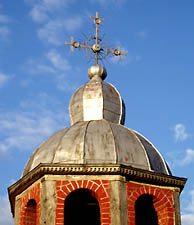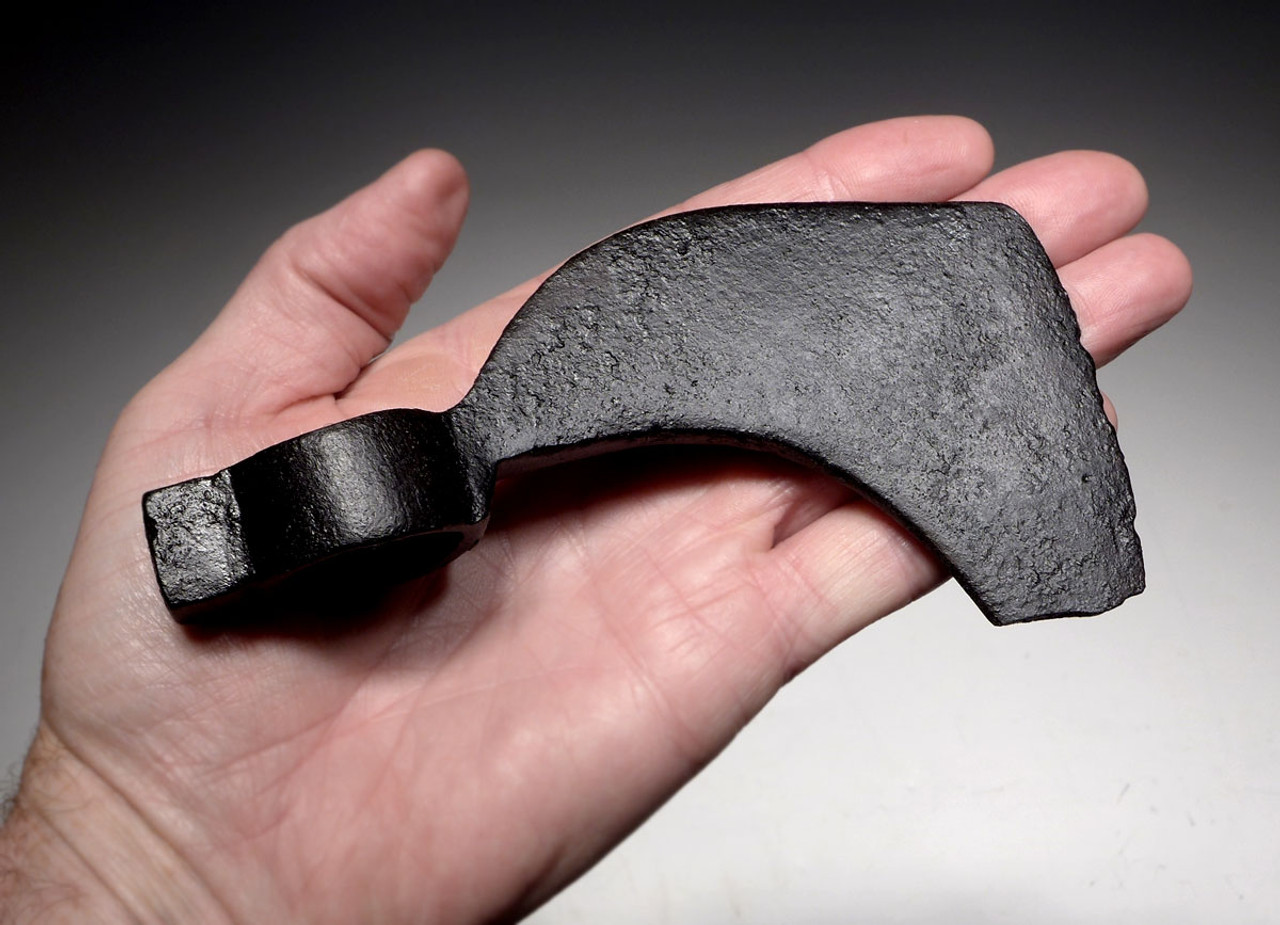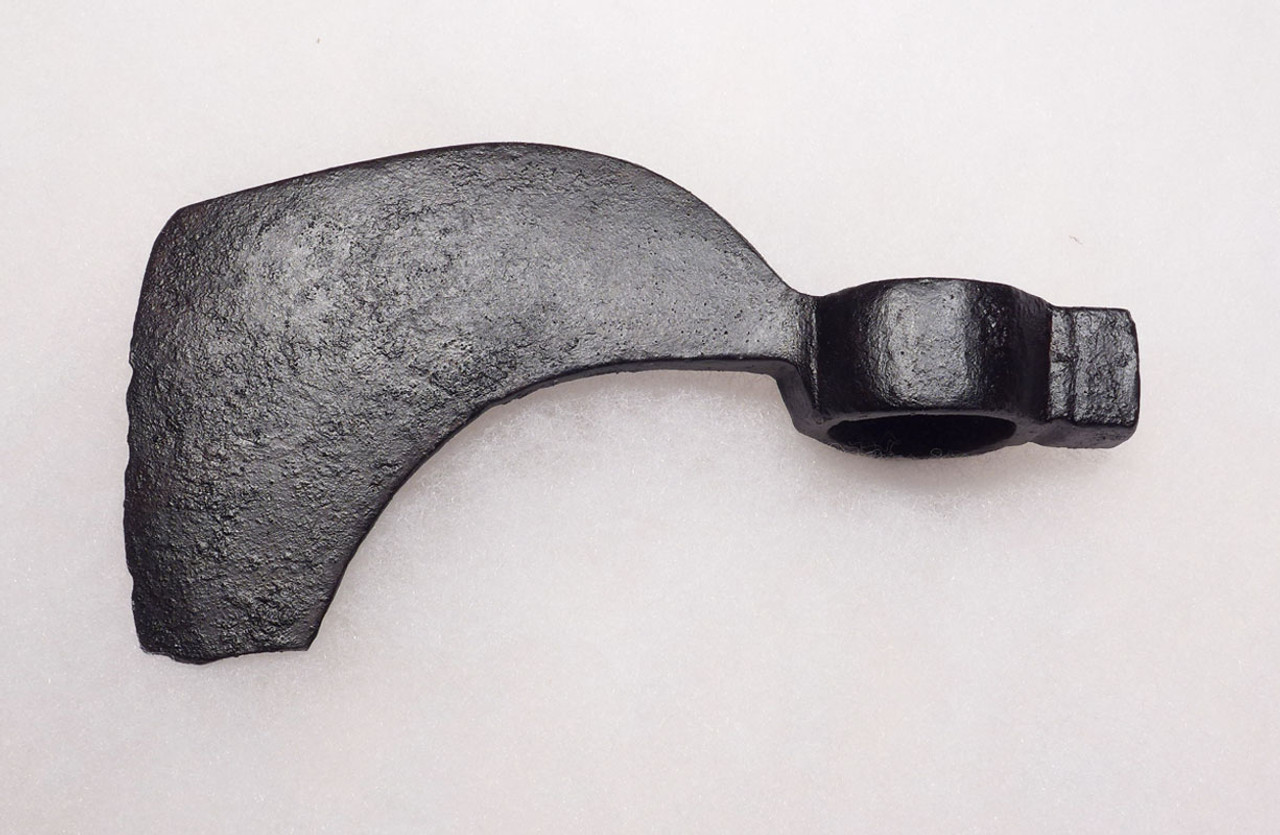Product Description
This is a rare, exceptionally well-preserved battle iron war shaft axe from the early Ottoman Empire, during the last days of, or early after the end of the Roman Byzantine Empire. It features a broad, drop blade with evidence of combat use on the chopping edge. It is complete with an unbroken shaft hole body and a hammer end on the back side that also would have proven effective in combat, against helmets and heavier armored enemies. Many of the original historic illustrations of this era, that depict combat between the armies of the Byzantine Roman and Ottoman Empires, show identical axes to this example, being used in battle.
This battle axe could have been equally been carried by either a mounted cavalry soldier, or by a ground infantryman. It would make a rare addition to an advanced collection of historic, ancient militaria from this pivotal period of world history. In the final days of the Byzantine Roman Empire, the area claimed by Romans was shrinking down to the city walls of Byzantium, ultimately ending in the siege and final invasion and destruction of the city in 1453 AD. The majority of the military forces on BOTH sides by this time, were made up of heavily armored cavalry yet, foot soldiers played still played an important role.
The battle axe was specifically designed for use in close quarter fighting. Many were suitable for use in one hand while others were much larger and were wielded with two hands. Compared to a sword swing, the axe delivers more cleaving power against a smaller target area, making it more effective against armor, due to concentrating more of its weight in the axe head. Infantry armed with axes were an intimidating force due to the severe injury that axes inflicted.
Unlike most metal artifacts sold on the market that are untreated and uncleaned, our specimens our properly cleaned, inspected and conserved in our museum conservation lab prior to being offered for sale to our clients. If ancient bronze or iron is NOT treated and stabilized correctly, IT WILL CONTINUE TO DISINTEGRATE AND CORRODE, AND COULD EVENTUALLY FALL APART INTO PIECES.
WARNING: There is an increasing number of fake ancient artifacts on the market with many dealers not having a lab facility or the knowledge to identify these fakes. As fine quality original specimens become more scarce, techniques have become more sophisticated to fake these artifacts. The degree to which the fakers have been able to replicate patina to disguise their work, requires expert examination by highly experienced individuals. There are many ancient artifacts being sold now, that are made up of part original and part modern components, or wholly modern pieces displaying artificial patinas. All purchases should include from the dealer, a written guarantee of authenticity with unconditional and lifetime return policies regarding such guarantee.
HISTORY
 Perhaps no other epoch in history is so unique, extensive and yet, as much forgotten as that of the Byzantine Roman Empire. From the founding of its new capitol in Constantinople, 330 AD to its final fall to the Ottoman invaders in 1453, over eleven hundred years of history has virtually been lost in most minds of the Western world. Ironically, it is this exact history that has extensively shaped the Western cultures today, especially those of the Christian faith.
Perhaps no other epoch in history is so unique, extensive and yet, as much forgotten as that of the Byzantine Roman Empire. From the founding of its new capitol in Constantinople, 330 AD to its final fall to the Ottoman invaders in 1453, over eleven hundred years of history has virtually been lost in most minds of the Western world. Ironically, it is this exact history that has extensively shaped the Western cultures today, especially those of the Christian faith.
No event in Western history was probably more pivotal than that of the Christian conversion of the Roman emperor Constantine I. Up to that time, Christians were heavily persecuted by many of the previous emperors and the religion was outlawed. That would all change in 324 AD with a miraculous military victory and subsequent conversion to Christianity by Constantine I at the Milvian Bridge. From this point on, Christianity became the official religion of the Empire. A new capitol was established in Constantinople (present day Istanbul, Turkey) and power was fully transferred from Rome to Constantinople in 476 AD. It was not the end of the Roman Empire but a continuation and fascinating transformation of Roman rule that would last for another one thousand years!
 In the Byzantine Period, the Roman Empire and Christianity were completely interwoven. It was the quintessential example of the UNION of church and state. What was once the ancient world's greatest enemy of the faith, overnight became its most devoted advocate. The classic architecture, style of dress, and overall appearance of all that was "Old Rome" took on a new and intricate style that the world has never seen before or since. This was not only attributed to the influence of the capitol's new geographic location, but also to the foremost prominence of Christianity in the Roman world.
In the Byzantine Period, the Roman Empire and Christianity were completely interwoven. It was the quintessential example of the UNION of church and state. What was once the ancient world's greatest enemy of the faith, overnight became its most devoted advocate. The classic architecture, style of dress, and overall appearance of all that was "Old Rome" took on a new and intricate style that the world has never seen before or since. This was not only attributed to the influence of the capitol's new geographic location, but also to the foremost prominence of Christianity in the Roman world.
A well-known remnant of the Byzantine Period is the stunning and unique art of the religious Icons. This abstract spiritual style can be immediately recognized and is evident in not only paintings and mosaics but also the era's architecture and coins. What was once thought of as crude numismatic issues are now appreciated as highly stylized symbols of the Romans' devout faith.
After the establishment of Constantinople as the new capitol and navel of the Roman world, the Empire continued for almost a millennium eventually bridging ancient and medieval history but not without its share of enemies. Numerous challenges of foreign armies took its toll on defenses and finally, on May 29, 1453 AD, the Muslim Ottomans overran the crumbling city walls and the sun set forever on the greatest empire that the ancient world had ever known.
 US DOLLAR
US DOLLAR
 EURO
EURO
 AUSTRALIAN DOLLAR
AUSTRALIAN DOLLAR
 CANADIAN DOLLAR
CANADIAN DOLLAR
 POUND STERLING
POUND STERLING














